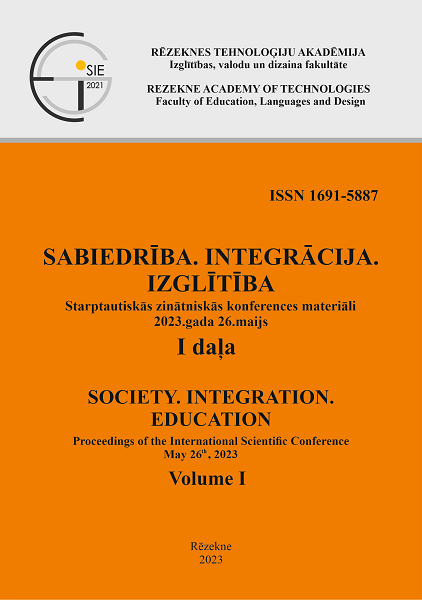CONSTRUCTION OF EXAMPLES AND COUNTEREXAMPLES IN PRIMARY SCHOOL TO VERIFY THE TRUTH OF STATEMENTS
DOI:
https://doi.org/10.17770/sie2023vol1.7071Keywords:
counterexample, critical thinking, logic, negation, statement, truth valueAbstract
In the modern mathematics learning process in school, the skill of creating examples and counterexamples in both familiar and new situations is emphasized. In the context of critical thinking, the construction of examples and counterexamples is an effective technique for evaluating statements and justifying arguments. This technique is suitable for students before other methods of proving general statements in mathematics are introduced.
The aim of the study is to highlight the topics of the study course "Elements of Mathematical Logic and Set Theory" for the Professional Bachelor's degree in Teacher Education, which are relevant for constructing examples and counterexamples. In the study, the qualitative and quantitative analysis of the answers of the students in teacher programs to the questions of the questionnaire about the student experience related to the ability to formulate examples and counterexamples was carried out. The research shows that the creation of examples and counterexamples to the given statements does not cause great difficulties. It is much more difficult to create statements with mathematical content for grades 1-6, the truth verification of which, using the technique of constructing examples and counterexamples, would activate the formation of understanding of mathematical concepts and relationships. In order to connect the topics of the "Elements of Mathematical Logic and Set Theory" course with the planned results of primary education, a qualitative content analysis of the Latvian primary education standard and the primary education program was carried out.
Based on the results obtained in the study, the authors identified several topics that are relevant in the course "Elements of Mathematical Logic and Set Theory".
References
Amirudin, M., Fuad, Y., & Wijayanti, P. (2018). Students’ Proof Schemes for Disproving Mathematical Proposition. Proceedings of the Mathematics, Informatics, Science, and Education International Conference (MISEIC 2018). Advances in Intelligent Systems Research (AISR), 157, 101-105. DOI: 10.2991/miseic-18.2018.25
Buchbinder O., & Zaslavsky, O. (2014). A Holistic Approach for Designing Tasks that Capture and Enhance Mathematical Understanding of a Particular Topic: The Case of the Interplay between Examples and Proof. In C. Margolinas (Ed.), Task Design in Mathematics Education. Proceedings of ICMI Study 22, (25-33). Oxford. Retrieved from: https://www.researchgate.net/publication/299346753_A_Holistic_Approach_for_Designing_Tasks_that_Capture_and_Enhance_Mathematical_Understanding_of_a_Particular_Topic_The_Case_of_the_Interplay_between_Examples_and_Proof
Cīrulis, J. (2007). Matemātiskā loģika un kopu teorija. Rīga: Zvaigzne ABC.
Doruk, M., & Doruk, G. (2022). Students’ ability to determine the truth value of mathematical propositions in the context of operation meanings. International Journal of Mathematical Education in Science and Technology, 53(4), 753-786. DOI: 10.1080/0020739X.2020.1782494
Geske, A., & Grīnfelds, A. (2006). Izglītības pētniecība. Rīga: LU Akadēmiskais apgāds.
Gruenwald, N., & Klymchuk, S. (2003). Using counter-examples in teaching calculus. The New Zealand Mathematics Magazine, 40 (2), 33-41. Retrieved from: https://openrepository.aut.ac.nz/bitstream/handle/10292/8392/Using%20Counter-Examples%20in%20Teaching%20Calculus-NZMM-2003-pre-publication.pdf?sequence=4&isAllowed=y
Horiguchi, T., & Hirashima, T. (2001). The Role of Counterexamples in Discovery Learning Environment: Awareness of the Chance for Learning. In T. Terano, Y. Ohsawa, T. Nishida, A. Namatame, S. Tsumoto, T. Washio (Ed.), New Frontiers in Artificial Intelligence. JSAI 2001. Lecture Notes in Computer Science, 2253, (468-474). Berlin, Heidelberg: Springer. DOI:10.1007/3-540-45548-5_64
Kachapova, F., Black, M., Klymchuk, S., & Kachapov, I. (2007). Counter-Examples and Paradoxes in Teaching Mathematical Statistics: A Case Study. Mathematics Teaching-Research Journal On-Line, 2(1), 1-12. Retrieved from: https://commons.hostos.cuny.edu/mtrj/wp-content/uploads/sites/30/2018/12/v2n1-Counterexamples-Paradoxes-Sergiy.pdf
Komatsu, K. (2010). Counter-examples for refinement of conjectures and proofs in primary school mathematics. The Journal of Mathematical Behavior, 29, 1-10. Retrieved from: https://www.researchgate.net/publication/223359741_Counter-examples_for_refinement_of_conjectures_and_proofs_in_primary_school_mathematics
Kurdyumova, N. А. (2001). Vse i nekotorye na odnom uroke. Matematika v shkole. 1, 34-35.
Mārtinsone, K., & Pipere. A. (2011). Ievads pētniecībā: stratēģijas, dizaini, metodes. Rīga: RAKA.
Mencis, J., & Kumerdanka, A. (2021). Sasniedzamais rezultāts matemātikā – prasme. Rīga: Latvijas Universitāte.
Ministru kabinets. (2018). Noteikumi par valsts pamatizglītības standartu un pamatizglītības programmu paraugiem. Ministru kabineta noteikumi Nr. 747. Pieejams: https://likumi.lv/ta/id/303768-noteikumi-par-valsts-pamatizglitibas-standartu-un-pamatizglitibas-programmu-paraugiem
Nodelman, V. (2018). Counterexamples in Mathematics Education: Why, Where, and How?--Software aspect. Electronic Journal of Mathematics and Technology, 12(3), 342+. Gale Academic OneFile, Retrieved from: https://go.gale.com/ps/i.do?id=GALE%7CA673463248&sid=googleScholar&v=2.1&it=r&linkaccess=abs&issn=19332823&p=AONE&sw=w&userGroupName=anon%7E824f0202
NMS. (2022). Piemērs un pretpiemērs. Teorija un piemēri 5.-9. klasei, gatavojoties Novada olimpiādei 2021./2022. m.g. Pieejams: https://www.nms.lu.lv/fileadmin/user_upload/lu_portal/projekti/nms.lu.lv/Teorija/Olimpiazu/Piemers_pretpiemers_5-9_klase_2022.pdf
Ryzhik, V. I. (2007). Logikа v shkolnom matematicheskom obrazovanii. Matematika v shkole. 3, 39-47; 4, 29-37.
Semadeni, Z. (1984). Action proofs in primary mathematics teaching and in teacher training. For the Learning of Mathematics, 4(1), 32-34. Retrieved from: https://www.flm-journal.org/Articles/7DE6E459B48131C6FD31327F97E5B.pdf
Skola2030. (2019). Pieejams: https://www.skola2030.lv
Sondore, A., Krastiņa, E., Daugulis, P., & Drelinga, E. (2016a). Understanding of basic concepts for mastering competences of school mathematics. Proceedings of the International Scientific Conference "Society. Integration. Education". Volume II, May 27-28. Rezekne: Rezeknes Academy of Technologies, 330-342. Retrieved from: http://journals.ru.lv/index.php/SIE/article/view/1383
Sondore, A., Krastiņa, E., Daugulis, P., & Drelinga E. (2016b). Usage of logical connectives in school mathematics. In M. Lepik (Ed.), Proceedings of the 17th International Conference "Teaching Mathematics: Retrospective and Perspectives", 123-131, Tallinn: Tallinn University.
Sondore, A., Krastiņa, E., Daugulis, P., & Drelinga, E. (2018). Construction of negations in the context of critical thinking for primary school. Proceedings of the International Scientific Conference "Society. Integration. Education". Volume II, May 25-26, 454-463, Rezekne: Rezeknes Academy of Technologies.
Zaskis, R., & Chernoff, E. J. (2008). What makes a counterexample exemplary. Educational Studies in Mathematics, 68, 195-208. DOI:10.1007/s10649-007-9110-4
Widjaja, W., & Vale, C. (2021). Counterexamples: challenges faced by elementary students when testing a conjecture about the relationship between perimeter and area. Journal on Mathematics Education, 12(3), 487-506. Retrieved from: https://www.researchgate.net/publication/356495788_COUNTEREXAMPLES_CHALLENGES_FACED_BY_ELEMENTARY_STUDENTS_WHEN_TESTING_A_CONJECTURE_ABOUT_THE_RELATIONSHIP_BETWEEN_PERIMETER_AND_AREA






